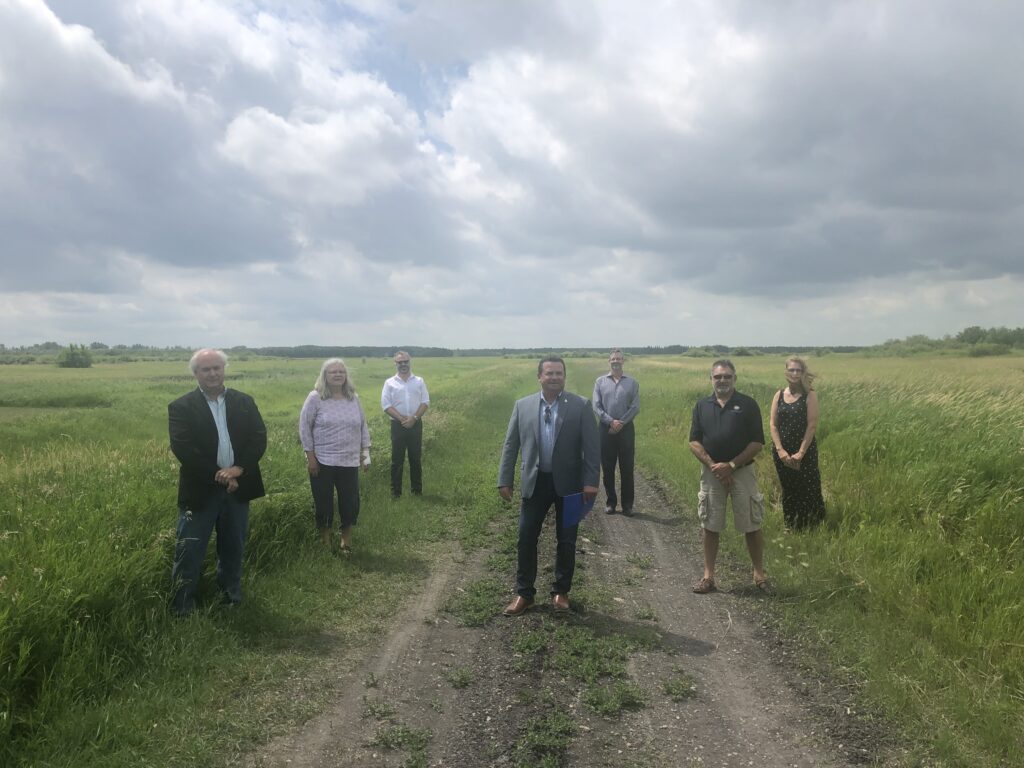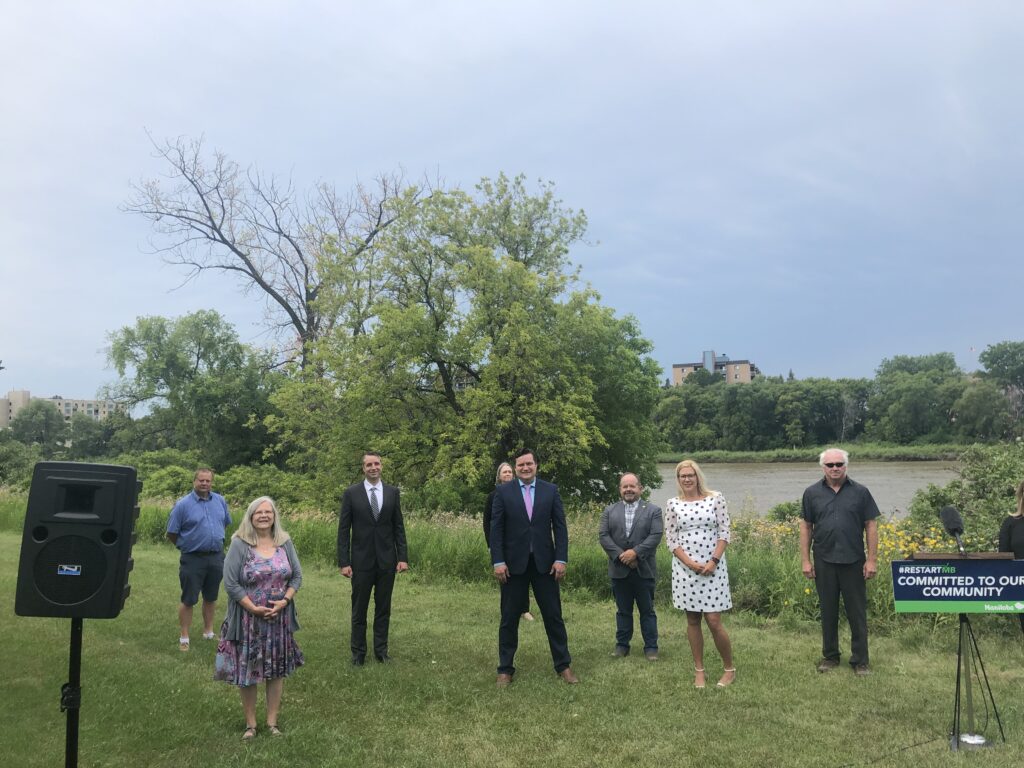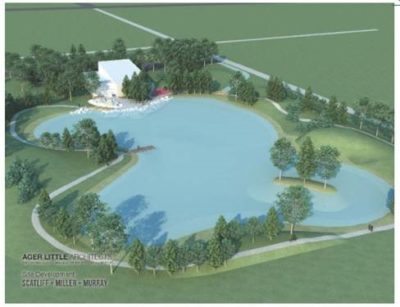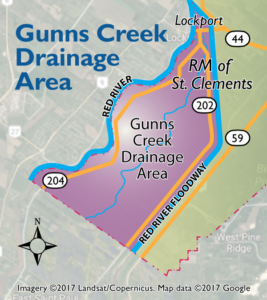Based on drainage data gathered over the past few years by surveying areas with overland flooding issues, five problem areas have emerged: Gunns Creek, Bunns Creek, Ashfield, Grand Marais and Devils Creek.
In 2018, the RM will start fixing trouble spots, continue to gather data, and work toward a long term sustainable water management plan to prevent future overland flooding.
Council is considering borrowing money for this project.
Gunns Creek Diversion Project fully funded by Province – July 23, 2020 Announcement


The R.M. of St. Clements Gunns Creek Diversion is a channel to divert water from Gunns Creek into the Red River. Gunns Creek flows through agricultural fields and some forested areas in our Municipality. It is heavily vegetated and typically remains dry between the months of July and March unless a significant rainfall event is experienced. Parts of the channel have been constructed while other parts are more natural. It is often incapable of conveying these flows efficiently in its current state. We have experienced firsthand localized flooding and ineffective drainage in the area which can cause significant damage to both crops and private homes and this increasing concern by residents in this area caused the RM to look at how to fix these problems. It is a constant vision and goal of ours to strengthen resiliency and reduce this risk for our residents and their properties.
We applied for the Gunns Creek Diversion Project with the Province of Manitoba for the Winnipeg Metropolitan Region Disaster Prevention and Climate Resiliency Program. On July 23, 2020 the Province of Manitoba announced the approval of 100% funding for $2.7 million towards the Gunns Creek Diversion Project, there is NO municipal contribution required. This project is scheduled to be completed by March 31, 2021, unless extenuating circumstances occur.
This project falls within the 2019 Municipal Strategic Plan goals for a comprehensive plan for roads, drainage and waste and to keep costs affordable and predictable for ratepayers. The proposed project will strengthen resiliency against the natural hazard of flooding and will lead to reduced risk in five key indicators – property impacts, environmental health, climate change, economic and agricultural capacity and quality of life.
The retention pond portion of the drainage project will be located at the future site of the South St Clements Community Building. Council’s exciting vision is to utilize the necessary retention pond to create a safe welcoming space where citizens can gather, meet and participate in activities. The final product will include aesthetic park landscaping and amenities such as trails, benches, and a floating island. Residents will have opportunities here for quiet reflection, unstructured play, walking, bike riding, walking pets, kayaking, canoeing, tobogganing, skating on the pond, and cross country skiing.

We are eager to begin on the Gunns Creek Diversion. We are confident this will assist in working toward a long term sustainable water management plan and to prevent future overland flooding. Project updates will be made available through our website and future newsletter editions.
Increasing concern by residents about flooding around homes and farmer’s fields in the Gunns Creek and Bunns Creek areas caused the RM to look at how to fix these problems.
In 2016, the RM conducted a drainage study in these areas. The engineer’s report suggests options for improving water flow and decreasing flooding, including cleaning drains (ditches), enlarging drains, and enlarging culverts.
Download Bunns Creek and Tributary Drains – Drain and Crossing Upgrades Hydrologic and Hydraulic Assessment here.
Download
Gunns Creek Hydrologic and Hydraulic Assessment Drain and Crossing Upgrades
here.
The RM recently hired a consultant to review these options, and will determine which will have the most impact in a cost effective way. Cost estimates for these areas are:
- Bunns Creek – $890,000 to $1,380,000
- Gunns Creek – $1,000,000 to $2,250,000
The RM is asking the province to partner on some of these improvements and has applied for grants. Council is also considering borrowing money to do some of the work.
The RM is in the process of conducting drainage studies in the Ashfield Road/Floodway Drive area and in the area of Anderson and Donald Streets in Grand Marais.
The RM is also investigating problem areas served by drains maintained by both the province and the RM, particularly in the central part of the RM east of Highway 59.
Some Background on Drainage
*From Manitoba Water Stewardship Regional Operations Drainage Infrastructure Water Rights Licensing
Land drainage is a partnership between landowners, municipalities, Conservation Districts and the Province. Basic agricultural land drainage works in the province were completed in the early 1900’s, under the jurisdictions of various municipally-based entities known as Drainage Districts. In the 1930’s and 1940’s provisions were made for the maintenance of the drains through the establishment of Drainage Maintenance Districts, again established on municipal boundaries.
In 1965 Manitoba took a proactive approach to resolving inter-municipal drainage issues by being the first of all surrounding jurisdictions to take on the responsibility for Provincial Waterways (the major drains) based on a watershed systems approach. In general, municipalities became responsible for those components of the tributary system which outlet into the Provincial Waterways.
During the 1960’s and the period between the late 1970’s and the mid 1980’s, a number of cost sharing programs between federal, provincial and municipal jurisdictions resulted in significant temporary boosts to drainage system reconstruction and development. The dryer cycle in regional weather of the late 1980’s, resulted in drainage issues becoming less prominent. A commensurate loss of federal support saw provincial technical and financial resources dedicated to drainage significantly reduced.
In 1989 the provincial government held a series of public consultations which resulted in the publication of Manitoba’s Water Policies. Drainage was raised as a significant issue. Drainage priorities were outlined as follows: maintenance of the existing system -first priority, reconstruction -second priority, and new construction -third priority. The policies further stated that drainage should be undertaken on a watershed basis in order to encompass issues related to water retention, control and timing of runoff.
During the 1990’s, a wetter than normal cycle predominated, revealing the effects of the deteriorated drainage infrastructure across the province, i.e. attendant crop and other flooding related damages. The increased profile of drainage issues also highlighted regulatory shortcomings. The Province responded by transferring staff to regional postings so that drainage regulation could be administered at the local level. Enforcement of The Water Rights Act was actively pursued for the first time. The result of these changes was quicker action on enforcement and a shorter turn around time on licensing. There was also a significant increase in drainage license applications.
